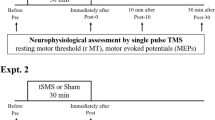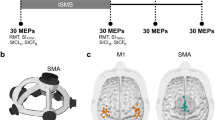Abstract
Primary motor cortex (M1) excitability is modulated by both ipsilateral limb movement and passive observation of movement of the contralateral limb. An interaction of these effects within M1 may account for recent research suggesting improved functional recovery of the impaired arm following stroke by viewing a mirror reflection of movements of the unimpaired arm superimposed over the (unseen) impaired arm. This hypothesis was tested in the present study using single-pulse transcranial magnetic stimulation (TMS) in eight neurologically healthy subjects. Excitability of M1 ipsilateral to a phasic, unilateral hand movement was measured while subjects performed paced (1 Hz), unilateral index finger-thumb opposition movements. Motor evoked potentials (MEPs) were obtained from the inactive first dorsal interosseous (FDI) in each of four viewing conditions: Active (viewing the active hand), Central (viewing a mark positioned between hands), Inactive (viewing the inactive hand) and Mirror (viewing a mirror-reflection of the active hand in a mirror oriented in the mid-sagittal plane) and with both hands at rest (Rest). MEPs were significantly enhanced during ipsilateral hand movement compared with the Rest condition (P<0.05). Largest MEPs were obtained in the Mirror condition, and this was significant compared with both the Inactive and Central viewing conditions (P<0.05). There was no difference between the dominant and non-dominant hand. Excitability of M1 ipsilateral to a unilateral hand movement is facilitated by viewing a mirror reflection of the moving hand. This finding provides neurophysiological evidence supporting the application of mirror therapy in stroke rehabilitation.


Similar content being viewed by others
References
Altschuler EL, Wisdom SB, Stone L, Foster C, Galasko D, Llewellyn DME, Ramachandran VS (1999) Rehabilitation of hemiparesis after stroke with a mirror. Lancet 353:2035–2036
Aziz-Zadeh L, Maeda F, Zaidel E, Mazziotta J, Iacoboni M (2002) Lateralization in motor facilitation during action observation: a TMS study. Exp Brain Res 144:127–131
Brodie EE, Whyte A, Waller B (2003) Increased motor control of a phantom leg in humans results from the visual feedback of a virtual leg. Neurosci Lett 341:167–169
Bütefisch CM, Davis BC, Wise SP, Sawaki L, Kopylev L, Classen J, Cohen LG (2000) Mechanisms of use-dependent plasticity in the human motor cortex. Proc Natl Acad Sci USA 97:3661–3665
Facchini S, Muellbacher W, Battaglia F, Boroojerdi B, Hallett M (2002) Focal enhancement of motor cortex excitability during motor imagery: a transcranial magnetic stimulation study. Acta Neurol Scand 105:146–151
Kilner JM, Paulignan Y, Blakemore SJ (2003) An interference effect of observed biological movement on action. Curr Biol 13:522–525
Liepert J, Dettmers C, Terborg C, Weiller C (2001) Inhibition of ipsilateral motor cortex during phasic generation of low force. Clin Neurophysiol 112:114–121
Maeda F, Kleiner-Fisman G, Pascual-Leone A (2002) Motor facilitation while observing hand actions: specificity of the effect and role of observer’s orientation. J Neurophysiol 87:1329–1335
Mudie MH, Matyas TA (1996) Upper extremity retraining following stroke: effects of bilateral practice. J Neurol Rehabil 10:167–184
Muellbacher W, Facchini S, Boroojerdi B, Hallett M (2000) Changes in motor cortex excitability during ipsilateral hand muscle activation in humans. Clin Neurophysiol 111:344–349
Muellbacher W, Ziemann U, Boroojerdi B, Cohen L, Hallett M (2001) Role of human motor cortex in rapid motor learning. Exp Brain Res 136:431–438
Muellbacher W, Ziemann U, Wissel J, Dang N, Kofler M, Facchini S, Boroojerdi B, Poewe W, Hallett M (2002) Early consolidation in human primary motor cortex. Nature 415:640–644
Ramachandran VS, Rogers-Ramachandran D (1996) Synaesthesia in phantom limbs induced with mirrors. Proc R Soc Lond B Biol Sci 263:377–386
Rossini PM, Rossi F (1998) Clinical applications of motor evoked potentials (editorial). Electroencephalogr Clin Neurophysiol 106:180–194
Sathian K, Greenspan AI, Wolf SL (2000) Doing it with mirrors: a case study of a novel approach to neurorehabilitation. Neurorehabil Neural Repair 14:73–76
Stedman A, Davey NJ, Ellaway PH (1998) Facilitation of human first dorsal interosseous muscle responses to transcranial magnetic stimulation during voluntary contraction of the contralateral homonymous muscle. Muscle Nerve 21:1033–1039
Stevens JA, Stoykov MEP (2003) Using motor imagery in the rehabilitation of hemiparesis. Arch Phys Med Rehabil 84:1090–1092
Strafella AP, Paus T (2000) Modulation of cortical excitability during action observation: a transcranial magnetic stimulation study. Neuroreport 11:2289–2292
Whitall J, Waller SM, Silver K, Macko RF (2000) Repetitive bilateral arm training with auditory cueing improves motor function in chronic hemiparetic stroke. Stroke 31:2390–2395
Acknowledgements
We would like to thank two anonymous reviewers for their helpful comments on an earlier version of this manuscript. We would also like to acknowledge the generous support for this work from the Australian Research Council.
Author information
Authors and Affiliations
Corresponding author
Rights and permissions
About this article
Cite this article
Garry, M.I., Loftus, A. & Summers, J.J. Mirror, mirror on the wall: viewing a mirror reflection of unilateral hand movements facilitates ipsilateral M1 excitability. Exp Brain Res 163, 118–122 (2005). https://doi.org/10.1007/s00221-005-2226-9
Received:
Accepted:
Published:
Issue Date:
DOI: https://doi.org/10.1007/s00221-005-2226-9




